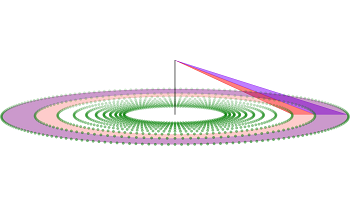
Both natural scene statistics and ground surfaces have been shown to play important roles in visual perception, in particular, in the perception of distance. Yet, there have been surprisingly few studies looking at the natural statistics of distances to the ground, and the studies that have been done used a loose definition of ground. Additionally, perception studies investigating the role of the ground surface typically use artificial scenes containing perfectly flat ground surfaces with relatively few non-ground objects present, whereas ground surfaces in natural scenes are typically non-planar and have a large number of non-ground objects occluding the ground. Our study investigates the distance statistics of many natural scenes across three datasets, with the goal of separately analyzing the ground surface and non-ground objects. We used a recent filtering method to partition LiDAR-acquired 3D point clouds into ground points and non-ground points. We then examined the way in which distance distributions depend on distance, viewing elevation angle, and simulated viewing height. We found, first, that the distance distribution of ground points shares some similarities with that of a perfectly flat plane, namely with a sharp peak at a near distance that depends on viewing height, but also some differences. Second, we also found that the distribution of non-ground points is flatter and did not vary with viewing height. Third, we found that the proportion of non-ground points increases with viewing elevation angle. Our findings provide further insight into the statistical information available for distance perception in natural scenes, and suggest that studies of distance perception should consider a broader range of ground surfaces and object distributions than what has been used in the past in order to better reflect the statistics of natural scenes.

Both natural scene statistics and ground surfaces have been shown to play important roles in visual perception, in particular, in the perception of distance. Yet, there have been surprisingly few studies looking at the natural statistics of distances to the ground, and the studies that have been done used a loose definition of ground. Additionally, perception studies investigating the role of the ground surface typically use artificial scenes containing perfectly flat ground surfaces with relatively few non-ground objects present, whereas ground surfaces in natural scenes are typically non-planar and have a large number of non-ground objects occluding the ground. Our study investigates the distance statistics of many natural scenes across three datasets, with the goal of separately analyzing the ground surface and non-ground objects. We used a recent filtering method to partition LiDAR-acquired 3D point clouds into ground points and non-ground points. We then examined the way in which distance distributions depend on distance, viewing elevation angle, and simulated viewing height. We found, first, that the distance distribution of ground points shares some similarities with that of a perfectly flat plane, namely with a sharp peak at a near distance that depends on viewing height, but also some differences. Second, we also found that the distribution of non-ground points is flatter and did not vary with viewing height. Third, we found that the proportion of non-ground points increases with viewing elevation angle. Our findings provide further insight into the statistical information available for distance perception in natural scenes, and suggest that studies of distance perception should consider a broader range of ground surfaces and object distributions than what has been used in the past in order to better reflect the statistics of natural scenes.